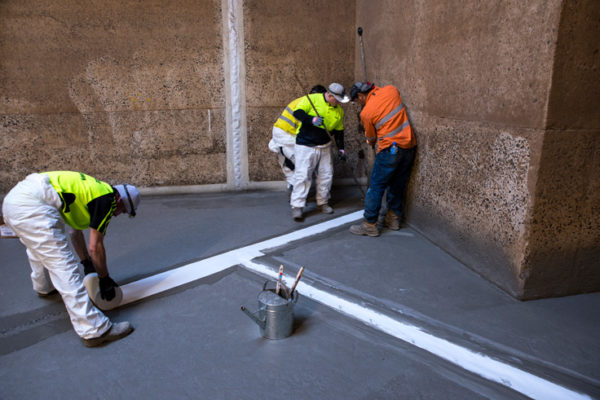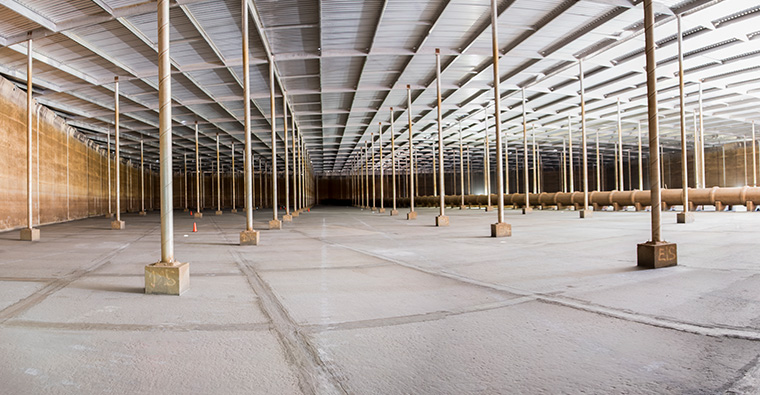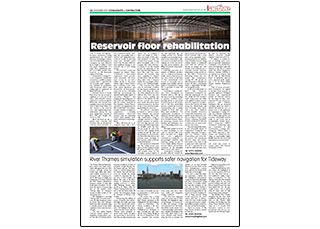In the December edition of Water Active, Graham James, OBE, explains how Flexcrete have provided a complete repair and protection solution for a major floor refurbishment project at Black Hill Reservoir, Sydney.
Over 73 tonnes of a high performance cementitious coating manufactured by UK-based Flexcrete Technologies Limited, one of the AkzoNobel group of companies, has been delivered by air freight to Sydney to meet the special requirements of a major floor rehabilitation project at an 86ML potable water reservoir in the Newcastle region of Australia. Cementitious Coating 851 – a two component, waterborne, cementitious modified polymer coating which is approved for use in public water supplies – was specified in combination with Cemprotec 2000-S joint sealing tape for application at Black Hill Reservoir.
Formerly known as Stoney Pinch Reservoir, the structure is significant as it was one of the major mid-twentieth century expansions of water storage for Newcastle, the second most populated area in the Australian state of New South Wales. It is also unusual as the reservoir was a major engineering project undertaken during the war years, having been constructed from 1939 and brought into service in 1941.
Black Hill Reservoir has a gravity mass concrete wall structure with an unreinforced concrete floor founded on rock. Located in remote bushland, the surrounding land is used for coal mining and access to the site is only via mine haul roads and unsealed gravel roads. Over the years, there has been significant damage to the reservoir due to local mining activity.
The reservoir is owned and managed by Hunter Water Corporation, a state-owned organisation which provides water, wastewater and storm water services for over half a million people in the lower Hunter region. Hunter Water’s area of operation covers some 5,366 square kilometres and incorporates six local government areas across a diversified landscape encompassing the vineyard and farming regions of Cessnock, Maitland and Dungog, the expanding areas of Newcastle and Lake Macquarie and the tourism peninsula of Port Stephens. Hunter Water’s operations are regulated by the New South Wales Government through a number of regulatory requirements including Environmental Protection Licences and an Operating Licence which specifies water quality and environmental regulations.
Black Hill Reservoir is an octagonal shape with a floor surface area of 11,000m2, a major axis length of 135m, a minor axis length of 90m and a total perimeter of 410m. The concrete floor consists of staggered rectangular 3.6m x 7.2m concrete slabs with a thickness of 230mm. A toe slab extends around the perimeter of the floor approximately 600mm out from the wall. The joints between the concrete slabs were originally ‘V Shaped’ around 50mm wide and 80mm deep, filled with a bitumen sealant. The total length of floor joints is over 5,000m in length.
The concrete floor slabs were in reasonable condition but the majority exhibited a full width crack along the minor axis in line with the joints of the adjacent slabs. There were also minor cracks, spalling and defects in the 600mm toe slab.
Surveys carried out several years earlier discovered minor vertical movement in the floor of up to 5mm, between emptying and filling the reservoir. The reservoir is periodically cleaned to remove accumulated sediment and maintain reservoir hygiene. This is typically undertaken using a squeegee attached to a rubber tracked excavator, in combination with high pressure water blasting. Agricultural type drains are installed under the floor slab just inside the wall of the reservoir with seepage drains installed around the walls and the perimeter at about foundation level. Both the internal and external drains discharge to four separate outlets at the toe of the embankment.
High Performance Cementitious Coating
The specification demanded that the sealing system must have a 20 year minimum design life and be certified for contact with potable water to the Australian standard AS4020. It was also important that the sealing system was flexible enough to accommodate movement of the wall and floor slabs and stresses associated with the ongoing use of the site, including daily partial depletion and filling and periodic emptying for maintenance.
Following assessment of a number of different products and as a result of an extensive tender process, Flexcrete products were chosen on the basis of their international track record of successful use in potable water facilities and the ability of Cementitious Coating 851 in particular to meet the client brief.
Cementitious Coating 851 was first introduced by Flexcrete back in 1985 and at the time it took the technology of polymer modified waterproofing slurries to new levels of performance. It still remains one of the best performing products available for structural waterproofing, and is widely adopted for both clean and dirty water installations. The sophisticated formulation is enhanced with microsilica inclusion which reacts with lime to form insoluble hydrates, thereby protecting concrete from leaching and subsequent erosion in demanding service conditions.
Normally applied by brush or spray techniques in two coats to wall and soffit areas, floors and decks are a simple one coat application. Cementitious Coating 851 is a pre-packaged material only requiring mixing on-site. It forms a highly alkaline, abrasion resistant surface with excellent resistance to the damaging effects of soft water attack.
Cementitious Coating 851 provides effective waterproofing on precast and in-situ reinforced concrete with a 2mm layer having equivalent waterproofing properties to 1000mm of good quality concrete. Being cement based, it chemically reacts with the substrate to become an integral part with intimate bond achieved over a saturated concrete substrate. Independent testing carried out at the VINCI Construction Technology Centre has confirmed that Cementitious Coating 851 will provide an effective barrier to chlorides for at least 28 years, a benchmark which is unparalleled throughout the global market.
In the case of the project at Black Hill Reservoir, Cementitious Coating 851 satisfied the requirement of a 20 year design life. The product’s rapid curing nature and ability to be applied to damp concrete were also important considerations, as the concrete was damp during the refurbishment and time constraints were severe with a very short shutdown period available. Structures coated with Cementitious Coating 851 can be returned to service in as little as 7 days’ curing, thereby minimising downtime. Products intolerant of substrate moisture were not even considered for this project.
The environmentally friendly and sustainable nature of Cementitious Coating 851 was another important consideration by Hunter Water Corporation as part of the tender process. The water-based, ultra-low odour and solvent-free nature of 851 makes it safe to apply even whilst water facilities are in operation. In some countries, additional taxes must be paid for materials that release excessive Volatile Organic Compounds (VOC’s).
Full Accreditation for Drinking Water Structures
 In addition to AS4020 for use on drinking water structures in Australia, Cementitious Coating 851 is also backed by a series of independent approvals relevant to the UK. It is listed under the Water Regulations Advisory Scheme (WRAS), is CE marked in accordance with BS EN 1504, has BBA (British Board of Agrément) approval and is approved under regulation 31 of the Water Supply (Water Quality) Regulations 2016.
In addition to AS4020 for use on drinking water structures in Australia, Cementitious Coating 851 is also backed by a series of independent approvals relevant to the UK. It is listed under the Water Regulations Advisory Scheme (WRAS), is CE marked in accordance with BS EN 1504, has BBA (British Board of Agrément) approval and is approved under regulation 31 of the Water Supply (Water Quality) Regulations 2016.
Over 73 tonnes of Cementitious Coating 851 was applied to the floor of the structure by specialist applicator McElligott Partners, an experienced installer of Flexcrete systems for the clean and dirty water industries. 851 was used in conjunction with Polymer Admixture 850, an advanced copolymer dispersion which is diluted with water for use as a primer prior to the application of Cementitious Coating 851. Like 851, Polymer Admixture 850 is WRAS approved for use in contact with potable water. In order to seal cracks and to accommodate further movement, Cemprotec 2000-S waterproof reinforcing tape was embedded in the Cementitious Coating 851. Cemprotec 2000-S, which is also WRAS approved, is elastomeric and waterproof, providing an impermeable, highly flexible seal over live cracks and expansion/construction joints.
Find Out More About Flexcrete’s High Performance Flooring Solutions
To download the article, please click on the button below:



